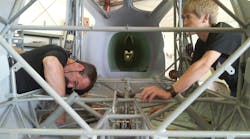The history of powered flight is 111 years old, but some of the most exciting developments in general aviation have taken place in just the last 25 years. Manufacturers are producing more types of aircraft than ever before. We’re bringing our products to new customers throughout the world. And we’re continuing to focus on safety by introducing new lower-cost technologies into aircraft that can help save lives.
Our industry has seen strong growth in recent decades. In 1989, general aviation manufacturers shipped 1,902 airplanes; in 2013, that total was 2,256 airplanes. We’ve expanded our product line from 17 different business jet models in 1989 to more than 40 models today. Manufacturers are making more large-cabin, long-range business jets, and more fuel-efficient models. And it’s not just the jet market that’s expanded. Today companies including Pilatus, Piper, Quest, and SOCATA are producing single-engine turboprops, when, 25 years ago, it was Cessna as the lone primary manufacturer.
Aircraft also have much more sophisticated equipment in them than they did in 1989. Navigation capabilities such as Wide Area Augmentation System (WAAS), in-cockpit weather, and glass cockpit technology are now commonplace in many aircraft. And think of the BRS Aerospace parachutes now installed in a number of small airplanes, which have saved more than 300 lives.
Continue to face challenges
Despite these exciting innovations, our industry has continued to face challenges—most notably from the recent economic recession. Deliveries fell from 4,276 airplanes in 2007 to 2,020 airplanes in 2010, and still have not fully recovered. But our industry has continued to develop new products to ensure we would be ready when customers decided they were once again ready to buy. With all segments up in 2013, and the market poised for future growth, that’s already proving to be a wise decision.
Additionally, when our industry faced venomous attacks about the use of corporate jets during the 2008 economic crisis, GAMA responded by partnering with the National Business Aviation Association to resurrect and rebrand the No Plane No Gain campaign to highlight the importance of business aviation. We also launched our successful General Aviation Jobs rallies, which we have held in a dozen states. Nothing shows governors, U.S. members of Congress, state legislators, county commissioners, and mayors the astounding economic impact of our industry more than looking directly into a crowd of hundreds of general aviation manufacturing employees in their town, district, or state.
The U.S. market remains extremely important to our industry, but our customer base has expanded exponentially in the past 25 years. Approximately 80 percent of our customers were based in North America in 1989. Today, about half of our customers are outside North America. As the general aviation aircraft market reaches deeper into Asia, South America, and the Middle East, more customers are learning about our products’ incredible value in supporting business travel, facilitating the boom in energy development, and transporting patients to receive needed medical care. GAMA has responded to this increased interest by expanding our presence in Brussels, hiring a representative in China, and opening an office in Dubai.
Focus on safety
Throughout all of these changes, our industry has remained focused on safety at all times. In 2011, for example, we helped reenergize the General Aviation Joint Steering Committee (GAJSC). This group of dedicated pilots, manufacturers, and regulators sifts through data about general aviation accidents to determine the leading causes of accidents and look at how future accidents can be prevented. Their work has helped push the installation of angle of attack (AoA) indicators in general aviation aircraft to warn pilots when an inadvertent spin or stall is about to occur. These low-cost, easy-to-install indicators are one of the most significant developments in general aviation aircraft in the last 25 years.
Another of the GAJSC’s areas of focus is System Component Failure — Powerplant (SCF-PP). Government and industry experts have examined 60 SCF-PP accidents in detail, from manufacturing and maintenance of the aircraft and to the pilot’s reaction when the engine malfunctioned. They found that improper maintenance was the leading cause of accidents, including pilots not adhering to recommended maintenance procedures. In addition, a number of accidents were caused by improper and incomplete maintenance. The group continues to look at survivability factors, pilot control issues, lack of data, and lack of engine monitoring, among other issues, and will release its report early next year.
The awareness raised by the GAJSC’s discussions is helping to make the skies safer. According to preliminary statistics from the National Transportation Safety Board (NTSB) released in September, last year marked the lowest accident rate on record for general aviation, with a rate of 1.05 fatal accidents per 100,000 flight hours. That’s real progress and makes the goal of 1 fatal accident per 100,000 flight hours by 2018 look increasingly likely.
What lies ahead?
As worthwhile as it is to look back over the past 25 years, it’s just as important to think about what lies ahead. The good news is that a number of new and exciting developments are on the horizon. The Next Generation Air Transportation System (NextGen) promises to transform the way we fly by improving safety, increasing the capacity of the airspace system, and reducing the complexity of Air Traffic Control. But this can only happen if all operators required to install ADS-B equipment do so before the FAA’s mandated Jan. 1, 2020 deadline. So far, only about 6,000 of the 120,000 to 140,000 general aviation aircraft that need to equip have done so — even though equipment is available, and it is easy to book time at an installation center. If this trend continues and people choose to wait to equip until immediately before the mandate, the lines will only grow longer and the laws of supply and demand will naturally drive up installation costs.
We also need certification processes that promote, rather than hinder, the introduction of new safety-enhancing technologies. Our manufacturers are constantly working on new products, but too often run into bureaucratic roadblocks that can delay them for years — making it extremely costly and frustrating to bring innovations to customers. We need the FAA to make needed certification improvements as part of the FAA Modernization and Reform Act of 2012. At the same time, we are working with other government regulators throughout the world, such as the European Aviation Safety Agency (EASA) and the Civil Aviation Administration of China (CAAC), to make it easier and more cost-efficient for manufacturers to give customers the products and technologies they demand.
As we think about future products, manufacturers need to encourage the development of our future workforce, too. That’s why GAMA has sponsored the Aviation Design Challenge with our partners at Build A Plane for the past two years. During that time, we’ve sent Science, Technology, Engineering, and Math (STEM) curriculum and software to more than 100 U.S. high schools. Three of those schools have sent students, teachers, and chaperones to Arlington, WA, to help assemble Glasair Sportsman airplanes and learn firsthand the joy of aviation craftsmanship. I’m proud that we’ve already announced the 2015 competition, and remain extremely grateful to GAMA member companies for continuing to make this important initiative possible.
Thanks to hard work, dedication, and innovation, general aviation manufacturers have significant accomplishments to show for the past 25 years. The challenge for the next quarter-century is to build on this legacy and grow our industry even more. I’m confident we’re up to the task.
Pete Bunce is president and CEO of the General Aviation Manufacturers Association (GAMA), which is headquartered in Washington, D.C., with additional offices in Brussels and Dubai, and representation in China. He and the GAMA staff travel worldwide engaging regulators, policy makers, and elected officials to promote general aviation and advance the interests of GAMA’s international membership of more than 85 airframe, avionics, engine, and component manufacturers, as well as the world’s leading business aviation maintenance, repair, and overhaul companies.




